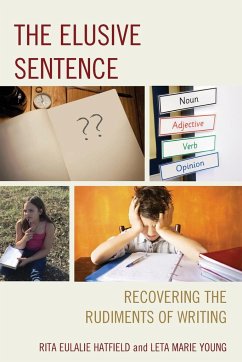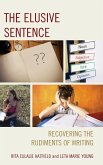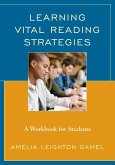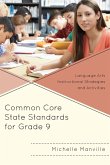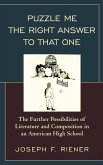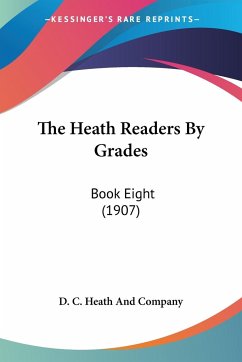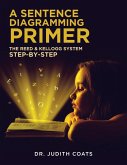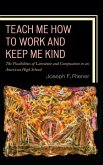- Broschiertes Buch
- Merkliste
- Auf die Merkliste
- Bewerten Bewerten
- Teilen
- Produkt teilen
- Produkterinnerung
- Produkterinnerung
This writing model is based on best practice and this sentence-level intervention serves as a precursor for mastering the new writing standards for CCSS. It offers novice writers a precise blueprint for what successful writing looks like and clearly defines the elusive sentence.
Andere Kunden interessierten sich auch für
![The Elusive Sentence The Elusive Sentence]() Rita Eulalie HatfieldThe Elusive Sentence96,99 €
Rita Eulalie HatfieldThe Elusive Sentence96,99 €![Learning Vital Reading Strategies Learning Vital Reading Strategies]() Amelia Leighton GamelLearning Vital Reading Strategies38,99 €
Amelia Leighton GamelLearning Vital Reading Strategies38,99 €![Common Core State Standards for Grade 9 Common Core State Standards for Grade 9]() Michelle ManvilleCommon Core State Standards for Grade 963,99 €
Michelle ManvilleCommon Core State Standards for Grade 963,99 €![Puzzle Me the Right Answer to that One Puzzle Me the Right Answer to that One]() Joseph F. RienerPuzzle Me the Right Answer to that One97,99 €
Joseph F. RienerPuzzle Me the Right Answer to that One97,99 €![The Heath Readers By Grades The Heath Readers By Grades]() D. C. Heath And CompanyThe Heath Readers By Grades32,99 €
D. C. Heath And CompanyThe Heath Readers By Grades32,99 €![A Sentence Diagramming Primer A Sentence Diagramming Primer]() Judith CoatsA Sentence Diagramming Primer30,99 €
Judith CoatsA Sentence Diagramming Primer30,99 €![Teach Me How to Work and Keep Me Kind Teach Me How to Work and Keep Me Kind]() Joseph F. RienerTeach Me How to Work and Keep Me Kind110,99 €
Joseph F. RienerTeach Me How to Work and Keep Me Kind110,99 €-
-
-
This writing model is based on best practice and this sentence-level intervention serves as a precursor for mastering the new writing standards for CCSS. It offers novice writers a precise blueprint for what successful writing looks like and clearly defines the elusive sentence.
Hinweis: Dieser Artikel kann nur an eine deutsche Lieferadresse ausgeliefert werden.
Hinweis: Dieser Artikel kann nur an eine deutsche Lieferadresse ausgeliefert werden.
Produktdetails
- Produktdetails
- Verlag: Rowman & Littlefield Publishers
- Seitenzahl: 172
- Erscheinungstermin: 8. Dezember 2015
- Englisch
- Abmessung: 229mm x 152mm x 10mm
- Gewicht: 259g
- ISBN-13: 9781475823394
- ISBN-10: 1475823398
- Artikelnr.: 43210401
- Herstellerkennzeichnung
- Libri GmbH
- Europaallee 1
- 36244 Bad Hersfeld
- gpsr@libri.de
- Verlag: Rowman & Littlefield Publishers
- Seitenzahl: 172
- Erscheinungstermin: 8. Dezember 2015
- Englisch
- Abmessung: 229mm x 152mm x 10mm
- Gewicht: 259g
- ISBN-13: 9781475823394
- ISBN-10: 1475823398
- Artikelnr.: 43210401
- Herstellerkennzeichnung
- Libri GmbH
- Europaallee 1
- 36244 Bad Hersfeld
- gpsr@libri.de
Both Leta and Eulalie started teaching in a small private school in Fairbanks, Alaska, yet most of their teaching careers were spent in a one-room school house in North Pole, Alaska. Eulalie earned her Master's in Educational Leadership at Concordia University in Portland, Oregon, and Leta earned her Master's in Cross Cultural Education at the University of Alaska at Fairbanks. Leta retired from classroom teaching to pursue a life-long passion, a three-year training program in French Classical Dressage, and Eulalie works as a private tutor for an international business couple, teaching their young daughter and traveling with them as needed. Both Leta and Eulalie continue to write and to develop multimodal resources for their cognitively differentiated writing workshop.
Introduction Part 1: Language Objective: Sentence-Level Writing
Intervention Why should we teach sentence level writing? Chapter 1 The
Problem: Inverted Writing Pedagogy Chapter 2 The Solution: Sentence-Level
Writing Chapter 3 Sentence-Level Writing Intervention Elementary Writing
Pedagogy Chapter 4 Linguistic & Musical Syntax Audiation Theory for
Music/Writing How do we teach sentence-level writing? Chapter 5
Ingham-Webster-Pudewa Method Dress-Ups Sample Writing Matrix Sentence
Openers & Decorations Phrase & Clause Manipulation Diagram Basic
Report/Essay Model Critique Model & Super Essay Model Scaffolding Common
Core State Standards for Writing Chapter 6 Writers: Middle School, High
School, College, & Beyond Advanced Stylistic Techniques Chapter 7 Sheltered
Instruction for Writing Part 2: Content Objective: Cognitively
Differentiated Learning What is cognitively differentiated learning?
Chapter 8 Cognitively Differentiated Learning Why should we teach academic
content through arts-integrated experiences? Chapter 9 Rationale: Teaching
through the Arts Art & Cognition Chapter 10 Arts-Integrated Learning
Rehearsal Effect Elaboration Effect Generation Effect Enactment Effect
Production Effect Effort After Meaning Effect Emotional Arousal Effect
Picture Superiority Effect Chapter 11 Arts-Integrated Instruction &
Cognition Writing: Cognitive & Physical Skills Cognitively Differentiated
Teaching & Learning Teaching & Learning Relationship Cognitively
Differentiated Writing Model Why should we teach academic content through
song? Chapter 12 Song as a Teaching Tool Balanced Learning through
Horizontal Differentiation Chapter 13 Operational Definitions Rationale:
Teaching Content through Song Chapter 14 Inherited Dissociated Philosophy
Historical Background of Mnemonic Learning Chapter 15 Neuroscience of Music
& Memory Memory & Music Music & Mnemonics Mnemonics & Diverse Learners
Assumptions & Final Thoughts on Mnemonic Song Chapter 16 Method & Practice:
Putting It All Together Cognitively Differentiated Writing Wheel Sample
Weekly Outline Pictures of Writing Journals Chapter 17 Best Practice for
Writing Instruction Chapter 18 Training Teachers for the New Millennium The
Hippocratic Oath for Educators Chapter 19 Final Reflection Appendix A
Arts-Integrated Resources Appendix B Writing Matrix Appendix C Composition
Checksheet Appendix D Sample Syllabus for College Course Appendix E
Webster's Formulas/Chants for Written Communication References
Intervention Why should we teach sentence level writing? Chapter 1 The
Problem: Inverted Writing Pedagogy Chapter 2 The Solution: Sentence-Level
Writing Chapter 3 Sentence-Level Writing Intervention Elementary Writing
Pedagogy Chapter 4 Linguistic & Musical Syntax Audiation Theory for
Music/Writing How do we teach sentence-level writing? Chapter 5
Ingham-Webster-Pudewa Method Dress-Ups Sample Writing Matrix Sentence
Openers & Decorations Phrase & Clause Manipulation Diagram Basic
Report/Essay Model Critique Model & Super Essay Model Scaffolding Common
Core State Standards for Writing Chapter 6 Writers: Middle School, High
School, College, & Beyond Advanced Stylistic Techniques Chapter 7 Sheltered
Instruction for Writing Part 2: Content Objective: Cognitively
Differentiated Learning What is cognitively differentiated learning?
Chapter 8 Cognitively Differentiated Learning Why should we teach academic
content through arts-integrated experiences? Chapter 9 Rationale: Teaching
through the Arts Art & Cognition Chapter 10 Arts-Integrated Learning
Rehearsal Effect Elaboration Effect Generation Effect Enactment Effect
Production Effect Effort After Meaning Effect Emotional Arousal Effect
Picture Superiority Effect Chapter 11 Arts-Integrated Instruction &
Cognition Writing: Cognitive & Physical Skills Cognitively Differentiated
Teaching & Learning Teaching & Learning Relationship Cognitively
Differentiated Writing Model Why should we teach academic content through
song? Chapter 12 Song as a Teaching Tool Balanced Learning through
Horizontal Differentiation Chapter 13 Operational Definitions Rationale:
Teaching Content through Song Chapter 14 Inherited Dissociated Philosophy
Historical Background of Mnemonic Learning Chapter 15 Neuroscience of Music
& Memory Memory & Music Music & Mnemonics Mnemonics & Diverse Learners
Assumptions & Final Thoughts on Mnemonic Song Chapter 16 Method & Practice:
Putting It All Together Cognitively Differentiated Writing Wheel Sample
Weekly Outline Pictures of Writing Journals Chapter 17 Best Practice for
Writing Instruction Chapter 18 Training Teachers for the New Millennium The
Hippocratic Oath for Educators Chapter 19 Final Reflection Appendix A
Arts-Integrated Resources Appendix B Writing Matrix Appendix C Composition
Checksheet Appendix D Sample Syllabus for College Course Appendix E
Webster's Formulas/Chants for Written Communication References
Introduction Part 1: Language Objective: Sentence-Level Writing
Intervention Why should we teach sentence level writing? Chapter 1 The
Problem: Inverted Writing Pedagogy Chapter 2 The Solution: Sentence-Level
Writing Chapter 3 Sentence-Level Writing Intervention Elementary Writing
Pedagogy Chapter 4 Linguistic & Musical Syntax Audiation Theory for
Music/Writing How do we teach sentence-level writing? Chapter 5
Ingham-Webster-Pudewa Method Dress-Ups Sample Writing Matrix Sentence
Openers & Decorations Phrase & Clause Manipulation Diagram Basic
Report/Essay Model Critique Model & Super Essay Model Scaffolding Common
Core State Standards for Writing Chapter 6 Writers: Middle School, High
School, College, & Beyond Advanced Stylistic Techniques Chapter 7 Sheltered
Instruction for Writing Part 2: Content Objective: Cognitively
Differentiated Learning What is cognitively differentiated learning?
Chapter 8 Cognitively Differentiated Learning Why should we teach academic
content through arts-integrated experiences? Chapter 9 Rationale: Teaching
through the Arts Art & Cognition Chapter 10 Arts-Integrated Learning
Rehearsal Effect Elaboration Effect Generation Effect Enactment Effect
Production Effect Effort After Meaning Effect Emotional Arousal Effect
Picture Superiority Effect Chapter 11 Arts-Integrated Instruction &
Cognition Writing: Cognitive & Physical Skills Cognitively Differentiated
Teaching & Learning Teaching & Learning Relationship Cognitively
Differentiated Writing Model Why should we teach academic content through
song? Chapter 12 Song as a Teaching Tool Balanced Learning through
Horizontal Differentiation Chapter 13 Operational Definitions Rationale:
Teaching Content through Song Chapter 14 Inherited Dissociated Philosophy
Historical Background of Mnemonic Learning Chapter 15 Neuroscience of Music
& Memory Memory & Music Music & Mnemonics Mnemonics & Diverse Learners
Assumptions & Final Thoughts on Mnemonic Song Chapter 16 Method & Practice:
Putting It All Together Cognitively Differentiated Writing Wheel Sample
Weekly Outline Pictures of Writing Journals Chapter 17 Best Practice for
Writing Instruction Chapter 18 Training Teachers for the New Millennium The
Hippocratic Oath for Educators Chapter 19 Final Reflection Appendix A
Arts-Integrated Resources Appendix B Writing Matrix Appendix C Composition
Checksheet Appendix D Sample Syllabus for College Course Appendix E
Webster's Formulas/Chants for Written Communication References
Intervention Why should we teach sentence level writing? Chapter 1 The
Problem: Inverted Writing Pedagogy Chapter 2 The Solution: Sentence-Level
Writing Chapter 3 Sentence-Level Writing Intervention Elementary Writing
Pedagogy Chapter 4 Linguistic & Musical Syntax Audiation Theory for
Music/Writing How do we teach sentence-level writing? Chapter 5
Ingham-Webster-Pudewa Method Dress-Ups Sample Writing Matrix Sentence
Openers & Decorations Phrase & Clause Manipulation Diagram Basic
Report/Essay Model Critique Model & Super Essay Model Scaffolding Common
Core State Standards for Writing Chapter 6 Writers: Middle School, High
School, College, & Beyond Advanced Stylistic Techniques Chapter 7 Sheltered
Instruction for Writing Part 2: Content Objective: Cognitively
Differentiated Learning What is cognitively differentiated learning?
Chapter 8 Cognitively Differentiated Learning Why should we teach academic
content through arts-integrated experiences? Chapter 9 Rationale: Teaching
through the Arts Art & Cognition Chapter 10 Arts-Integrated Learning
Rehearsal Effect Elaboration Effect Generation Effect Enactment Effect
Production Effect Effort After Meaning Effect Emotional Arousal Effect
Picture Superiority Effect Chapter 11 Arts-Integrated Instruction &
Cognition Writing: Cognitive & Physical Skills Cognitively Differentiated
Teaching & Learning Teaching & Learning Relationship Cognitively
Differentiated Writing Model Why should we teach academic content through
song? Chapter 12 Song as a Teaching Tool Balanced Learning through
Horizontal Differentiation Chapter 13 Operational Definitions Rationale:
Teaching Content through Song Chapter 14 Inherited Dissociated Philosophy
Historical Background of Mnemonic Learning Chapter 15 Neuroscience of Music
& Memory Memory & Music Music & Mnemonics Mnemonics & Diverse Learners
Assumptions & Final Thoughts on Mnemonic Song Chapter 16 Method & Practice:
Putting It All Together Cognitively Differentiated Writing Wheel Sample
Weekly Outline Pictures of Writing Journals Chapter 17 Best Practice for
Writing Instruction Chapter 18 Training Teachers for the New Millennium The
Hippocratic Oath for Educators Chapter 19 Final Reflection Appendix A
Arts-Integrated Resources Appendix B Writing Matrix Appendix C Composition
Checksheet Appendix D Sample Syllabus for College Course Appendix E
Webster's Formulas/Chants for Written Communication References

